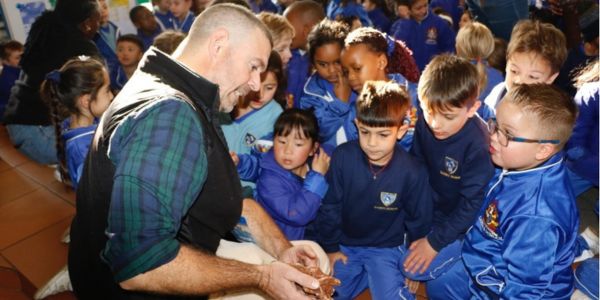Dinosaurs help us understand the natural world today
- Wits University
Wits palaeontologists visit SAHETI School to provide a fossil learning opportunity for children through a mini dinosaur show.

"When did you find your first dinosaur?" "Where can we find dinosaurs in South Africa?"
These were some of the pressing questions young learners posed to a team of Wits University palaeontologists visiting the Saheti School in Bedfordview, Johannesburg, recently.
This was the second outreach to the school by Professor Jonah Choiniere from the Evolutionary Studies Institute at Wits, accompanied by three PhD students, Atashni Moopen, Chandelé Montgomery, and Lutendo Mukwevho, and Master of Science student Enele Twala. The aim of the outreach is to expose Grade R learners to the discoveries of South African dinosaurs.
The Wits team gave a short presentation about their work as palaeontologists, demonstrating the tools of their trade and showing videos depicting a day in the life of a dinosaur dig.
Learners also had the chance to see and touch fossil replicas of South African dinosaurs from Wits’ vast collection of fossils. The visit concluded with a fun appearance by an inflatable T. rex and some delicious fossil-shaped biscuits made by a local bakery.
Outreach activities are a crucial part of Choiniere's research programme that aims to inspire the next generation of South African palaeontologists. He has worked with schools across greater Johannesburg and in the rural village of Qhemegha to raise awareness about the fascinating world of South African dinosaurs.
"I hope South African learners develop a sense of pride in their dinosaurs, like the giant plant-eater Ledumahadi and the early carnivore Dracovenator. These extinct animals are part of our unique national heritage," said Choiniere.
"It provides learning opportunities for children to discover different worlds they're not exposed to," said Perregil.
During the visit, Choiniere shared insights with the students on how they find fossils. "We find an area with lots of exposed rocks of a known age, and we walk very slowly. As soon as we find a fossil, we brush carefully. Sometimes it turns into a whole skeleton, and sometimes it's just a single broken bone," he explained.
He also highlighted the broader significance of studying dinosaurs. "When we study dinosaurs, we're studying how animals work. For example, by examining birds, we try to figure out how they hear and evolve new ways of hearing. We can extend these lessons back to dinosaurs,” said Choiniere.
“Dinosaurs can show us something we don't see today. If you wanted to ask questions like, 'How do animals get big? How do big animals evolve?' we can look at dinosaurs for answers.
Dinosaurs ruled the earth for 140 million years, far longer than humans have been around. They might have something to teach us about coping, treating the earth, and surviving for such a long time. They help us understand the natural world today and the natural world today helps us understand how dinosaurs lived."

